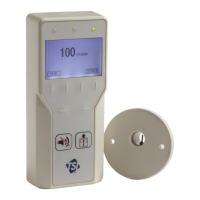Part One
Operator Keys
There are two dedicated keys on the front of the unit that each provides a critical function.
MUTE key
The MUTE key silences an audible alarm. The alarm remains silent until the
MUTE TIMEOUT value has been reached or the unit returns to control set point.
Pressing the MUTE key twice will permanently mute the alarm.
NOTE You can program the unit so that the audible alarm cannot be muted
(see menu item MUTE_BUTTON).
EMERGENCY key
The EMERGENCY key puts the controller into emergency mode. The controller
maximizes the exhaust flow and face velocity (if applicable) by modulating the
damper or venturi valve to full open position.
Pressing the EMERGENCY key will cause ”EMERGENCY” to appear on the
display, the red alarm light to flash on and off, and the audible alarm to beep
intermittently. To return to control mode press the EMERGENCY key or the
RESET key.
The Model FHM10 monitor and FHC50 controller can be configured so the
audible alarm is silenced during emergency mode. See menu item
EMERGENCY_AUD.
USB Port
There is a USB port at the bottom of the case. This USB port can be used with TSI’s Fume Hood
Configuration Software.
Alarms
The Model FHC50 controller has visual (red light) and audible alarms to inform you of changing
fume hood conditions. The alarm levels (set points) are determined by facilities staff, which could
be Engineering, Industrial Hygiene, or a facilities group depending on how the safety staff is
organized.
The alarms, audible and visual, will activate whenever the preset alarm level is reached. The
alarms will activate if the face velocity is low or inadequate, high or too great, or when the
exhaust airflow is too low or too high (need optional flow device installed). When the fume hood is
operating safely, no alarms will sound.
Example: The low alarm is preset to activate when the face velocity falls below 60 ft/min. When
the face velocity drops below 60 ft/min, the audible and visual alarms activate. The
alarms turn off (when set to unlatched) when the unit returns to the safe range, which
is defined as 20 ft/min greater than alarm set point (80 ft/min).
Visual Alarm
The red light on the front of the unit indicates an alarm condition. The red light is on for all alarm
conditions, low alarms, high alarms, and emergency. The light is on continuously in a low or high
alarm condition, and flashes in an emergency condition.

